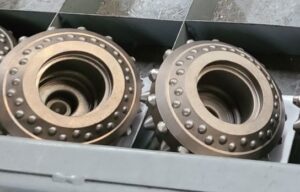Introduction
Drilling bits like PDC (Polycrystalline Diamond Compact) and tricone bits undergo high stress in extreme drilling environments. Each bit experiences rapid heating from friction as it cuts through hard rock, followed by quick cooling from drilling fluid. These temperature cycles stress the bit material, creating fatigue that leads to fractures. Testing under controlled thermal cycles helps engineers understand these stress effects. This article examines thermal cycling in PDC and tricone bits, looking at how we can improve materials to boost fatigue resistance.
Thermal Fatigue in Drilling Bits
Thermal fatigue occurs when materials face repeated heating and cooling. For PDC and tricone bits, the heating occurs as they contact hard rock, while cooling comes from drilling fluid. Each cycle causes small expansions and contractions. Over time, these changes create microcracks in the bit. In PDC bits, diamond coatings and tungsten help withstand these cycles but remain vulnerable to thermal stress. For tricone bits, fatigue is managed by using high-strength steels with strong carbide teeth. Each bit type requires specific approaches to counteract thermal fatigue.
Thermal Cycling Test Setup
Thermal cycling tests simulate the heating and cooling cycles bits face. In a typical test, a PDC bit is heated to 300°C and then cooled rapidly. The cycle repeats several times. For tricone bits, additional mechanical stress is applied during these cycles. Researchers measure stress levels and failure points under different conditions. Testing allows engineers to find temperature limits that cause cracking. Data from these tests is vital to improving bit designs and materials. By controlling thermal cycles in testing, manufacturers gain insight into real-world durability.
Material Optimization for Fatigue Resistance
To improve fatigue resistance, materials in PDC and tricone bits are selected carefully. In PDC bits, a mix of diamond and tungsten enhances durability. Diamond offers hardness, while tungsten provides stability under heat cycles. In tricone bits, strong steel alloys and carbide inserts manage both thermal and mechanical stress. Composite structures are also being developed. These composites combine metals with ceramics or other materials that resist thermal expansion. Advances in materials science allow engineers to create bits that endure extreme conditions longer.
Real-World Application and Benefits
Testing results guide manufacturers in creating bits for high-temperature and deep-well applications. With improved fatigue resistance, PDC and tricone bits last longer in demanding formations. Reduced wear lowers the need for frequent replacements, cutting costs. In oil and gas drilling, where efficiency and durability are key, fatigue-resistant bits improve productivity. Operators can drill longer without interruption, and each bit provides more consistent performance. By focusing on fatigue resistance, the industry creates bits better suited to harsh drilling environments.
Conclusion
Thermal cycling tests offer critical data for improving the fatigue resistance of drilling bits. By understanding how PDC and tricone bits perform under temperature cycles, manufacturers can design bits that resist extreme stresses. Enhanced materials like diamond-tungsten for PDC bits and carbide-tipped steel alloys for tricone bits have made significant advances. Continued research into thermal cycling and material optimization promises to push the boundaries of drilling efficiency, ensuring tools that perform reliably in the toughest formations.


